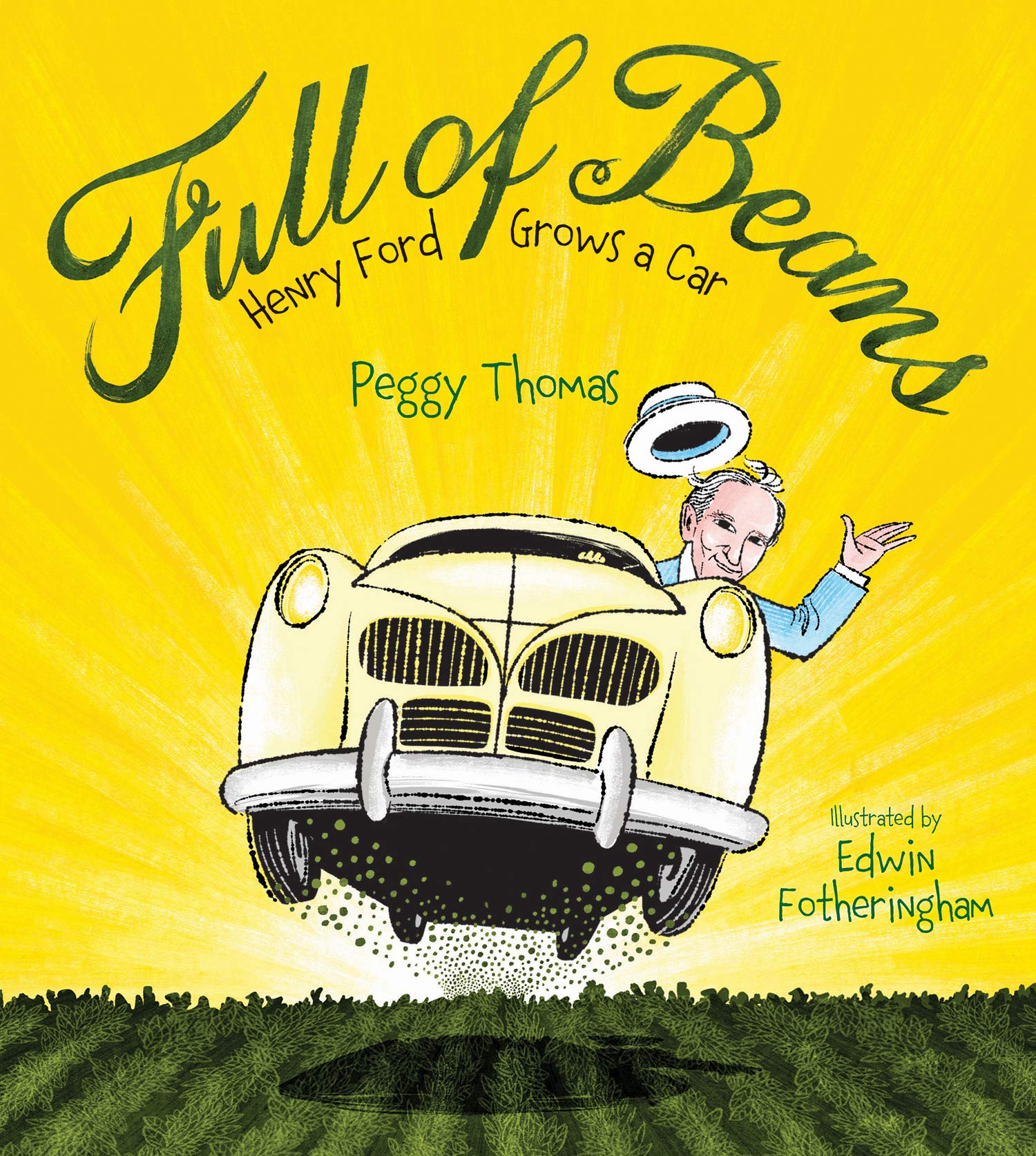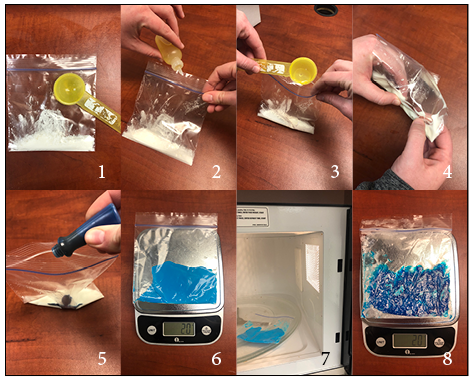 Relevancy and Engagement
maine.agclassroom.org
Relevancy and Engagement
maine.agclassroom.org
Full of Beans: Henry Ford Grows a Car
Grade Level
Purpose
Students identify the variety of soybeans uses for human consumption, livestock feed, and industrial products, explain how key historical events affected soybean production in the United States, and create a bioplastic made from soybeans. Grades 3-5
Estimated Time
Materials Needed
Engage:
- What is it? PowerPoint Slides
- Soybean Information Sheet
Activity 1: Full of Beans
- Full of Beans: Henry Ford Grows a Car by Peggy Thomas
- Full of Beans Timeline handouts (1 page per student)
- Colored pencils, markers, etc.
Activity 2: Soybean Plastic
- Cornstarch
- Soybean oil (vegetable oil)
- Sandwich-sized resealable bag
- Liquid food coloring
- Microwave
- Water
- Pipette or eye dropper
- Tablespoon measuring spoon
- Kitchen scale (1 per group)
- Soybean Plastic lab sheet
- Properties of Matter PowerPoint Slides
Vocabulary
lecithin: a generic term used to describe any group of fatty substances occurring in animal and plant tissues which attract both water and fat substances; used for smoothing food textures, emulsifying, homogenizing liquid mixtures, and repelling sticking materials
legume: a type of plant which has seeds contained in a pod such as a soybean, pea, or alfalfa plant
Did You Know?
- The United States leads the world in Soybean production.1
- One acre of soybeans can produce 40,000 servings of tofu, 2,500 gallons of soy milk, or 82,368 crayons.1,2
- Illinois, Iowa, and Minnesota are the top soybean-producing states in the U.S.3
- Today, more than 32,000 soybeans are used to make some of the 300 pounds of plastic that go into every Ford vehicle. The seats in Ford vehicles are even filled with soy foam!4
Background Agricultural Connections
Seventy-five million acres of U.S. farmland are used to grow one of the most versatile crops—soybeans!1 Soybeans first arrived in the United States in 1765 and were planted in Georgia by British colonist Samuel Bowen. Today, soybeans are grown predominately in the Midwest, which includes top soybean-producing states Illinois, Iowa, and Minnesota.3 During the summer, this legume is a bright green, leafy plant that transforms to bright yellow in the fall. One soy plant produces about eight pods that contain three or four beans each.
Believe it or not, soybeans find their way into almost everything! George Washington Carver is credited for discovering the value of oil and protein found in soybeans. Because of their high oil and protein content, soybeans are especially useful in manufacturing various products from food to biodiesel. Soybean oil is used in food products such as margarine, salad dressings, and cooking oil. It can also be found in industrial products such as biodiesel fuel and plastics. Lecithin (extracted from soybean oil) is a natural emulsifier and lubricant used in products like pharmaceuticals and protective coatings.4 After the extraction of soybean oil, the remaining parts can be processed into various edible soy protein products or used to produce soybean meal for livestock feed.4
Henry Ford and the Soybean
Henry Ford, the founder of Ford Motor Company, was told by his mother at a young age, “Do something useful.” Besides building the Model T and transforming the automobile industry, Henry Ford also made an impact on agriculture and soybean production. After the Great Depression hit, Henry Ford was determined to help farmers. After years of research, he discovered that soybeans were the answer. He created a new market for farmers and kept hundreds of Michigan soybean farmers busy. Soon, Henry Ford was incorporating soybeans into every aspect of his life, including paint, plastics, food, and clothing. However, he wanted to do more—he wanted to drive soybeans. In 1934, Henry Ford started using soy-based paint on his cars, and by 1935 he was boasting that a bushel of soybeans goes into every Ford car.4 In 1941, Henry presented his soybean plastic car to the world. It was lightweight and fuel-efficient; however, when the United States entered WWII, production of the soybean plastic car came to a halt. Today, soybeans are still used extensively by Ford Motor Company. More than 32,000 soybeans are used to make some of the 300 pounds of plastic that go into every Ford vehicle.4
Engage
- Display slide 1 of the What is it? PowerPoint Slides to the class. This photo can be projected on the board or printed out and passed around to groups of students, or both.
- Explain to the students that each of these products all contain one common ingredient. Allow students to guess ingredients and share ideas.
- Begin playing “What is it?” with the students by reading off each of the clues on the What is it? PowerPoint (slides 2-5).
- Allow students to guess ideas and ask questions.
- Show the students the Soybean Information Sheet and discuss the different uses of soybeans.
- Using the information from the Background Agricultural Connections, introduce soybeans to the students. Have the students determine if they live in a region of the United States that produces soybeans.
- Ask the students the following questions to lead a class discussion:
- Why are soybeans an important agricultural commodity?
- How has U.S. history affected soybean production in United States?
- What impacts do soybeans have on consumers?
- Explain to the students that they will explore why soybeans are an important commodity, their role in U.S. history, and the impacts soybeans have on consumers.
Explore and Explain
Activity 1: Full of Beans
- Before beginning, ask the students if they know anything about Henry Ford. Allow the students to share thoughts and ideas.
- Read
 the book Full of Beans: Henry Ford Grows a Car by Peggy Thomas.
the book Full of Beans: Henry Ford Grows a Car by Peggy Thomas. - Pass out a Full of Beans Timeline page to each student or pair of students.
- Instruct the students to color and illustrate a photo depicting their assigned date.
- When all students have finished their timeline photos, hang each of the pages up in order on a wall in the classroom.
- Ask the students to brainstorm which historical events Henry Ford experienced in his lifetime. (The Second Industrial Revolution, the Great Depression, and Pearl Harbor)
- Hang the three historical event captions up below the appropriate year.
- 1913: The Second Industrial Revolution
- 1929: The Great Depression begins
- 1941: The United States enters WWII (Pearl Harbor)
- Consider asking students the following questions to lead a class discussion:
- What is the difference between The First and Second Industrial Revolutions? (The First Industrial Revolution caused the growth of industries including coal, iron, railroads, and textiles. The Second Industrial Revolution focused on steel production, automobiles, and advances in electricity. Henry Ford introduced the assembly line during The Second Industrial Revolution.)
- How did the Great Depression affect Henry Ford and soybeans? (Henry Ford hated waste. He wanted to recycle and reuse everything. Henry discovered that soybeans were very versatile and could create a new market for farmers.)
- How did WWII affect the soybean plastic car? (The soybean plastic car was put in storage while Ford Motor Company began building bomber planes. The soybean plastic car’s metal frame may have been used in the war effort.)
- What other events in Henry Ford’s life had an impact on him or his career?
- Direct the focus back to soybean plastic by asking the following questions:
- How can soybean plastic be used today?
- Why is soybean plastic considered biodegradable?
- What product(s) would students design using soybean plastic?
Activity 2: Soybean Plastic
- To introduce the term “bioplastic” to students, write “bioplastic” on the board and break it into two parts. “Bio” means life. “Bioplastic” is plastic that comes from a living thing. Two common bioplastics are corn plastic and soybean plastic.
- Ask students to consider other plastic items in the classroom that are not made from bioplastic. Ask the students, "What is this plastic made from?" (Many plastic items are petroleum-based, which is a nonrenewable resource from the earth.) Note: for an introductory activity on renewable and nonrenewable resources, see Activity 2 in the lesson, Corn An A-maizing Plant: Food, Fuel, and Plastic.
- Explain to the students that they will be making a bioplastic using materials that come from the soybean plant and renewable resources.
- Divide the class into groups of 3-4 students. Provide each student with a copy of the Soybean Plastic lab sheet and a resealable sandwich-sized plastic bag.
- Give each group cornstarch, soybean oil, liquid food coloring, water, a pipette or eye dropper, a tablespoon measuring spoon, a kitchen scale, and access to a microwave.
- Instruct the students to follow the step-by-step procedures on the lab sheet and answer each of the questions.
- Soybean plastic procedures:
- Place 1 tablespoon of cornstarch into the plastic bag. (Figure 1)
- Add 2 drops of soybean oil. (Figure 2)
- Add 1 tablespoon of water. (Figure 3)
- Close the bag and knead it with fingers, mixing the contents. (Figure 4)
- Add 2 drops of food coloring. (Figure 5)
- Seal the bag and mix remaining contents.
- Open the bag slightly so it can vent.
- Weigh the contents of the bag on a kitchen scale. (Figure 6)
- Heat the bag in the microwave for 20-25 seconds. (Figure 7)
- Remove the bag from the microwave and let the plastic cool. Caution: The bag and contents will be hot!
- Weigh the contents of the bag again. (Figure 8) Compare the weight measurements from before and after microwaving.

- Using the Properties of Matter PowerPoint, discuss physical and chemical changes with the students. Ask, "Is soybean plastic a physical or chemical change?" (Chemical)
- Discuss the weight of matter when new substances have been formed. Ask the students:
- How much does the plastic weigh (in grams) after the changes occurred?
- Is this weight close to the starting weight?
- Why or why not?
- Explain to the students that regardless of the type of change that occurs when heating, cooling, or combining substances, the total weight of matter is conserved. Their bioplastic should weigh very close to the starting weight before it was heated.
- Wrap up the bioplastic activity by asking students to consider everyday plastic objects that they use. Consider asking the following questions to promote critical thinking:
- What objects can be made with bioplastic? (Disposable items such as packaging, cutlery, and bowls are common. Some companies have even produced bioplastic toys.)
- How does plastic and bioplastic affect the environment?
- How does bioplastic affect farmers?
- Would Henry Ford’s soybean plastic car work in today’s world?
Elaborate
-
Visit the Interactive Map website and view the Soybean map. Discover what states produce the most soybeans. Does your state produce soybeans?
-
Use the Soybean Living Necklace kit to familiarize students with the soybean plant. Allow students to plant a living soybean necklace where they can track the growth and development of a germinating soybean seed. This kit is available for purchase from agclassroom.org.
-
View the video Farm to Car to explore the ways in which Ford Motor Company is continuing Henry Ford's legacy by using plant-based plastics in their products.
Evaluate
After conducting these activities, review and summarize the following key concepts:
- Soybeans are a versatile crop used for human consumption, livestock feeds, industrial products, and household products.
- The versatility of soybeans for food and industrial products was discovered by Henry Ford as a result of the Great Depression.
- Bioplastics are made from biological materials produced on farms.
Sources
- https://www.aexcelcorp.com/blog/eco-friendly-traffic-paint/20-interesting-facts-about-americas-soybeans
- https://www.farmflavor.com/at-home/cooking/soybean-fun-facts/
- https://www.nass.usda.gov/Publications/AgCensus/2017/Full_Report/Volume_1,_Chapter_1_US/usv1.pdf
- Full of Beans by Peggy Thomas
- https://www.nass.usda.gov/Charts_and_Maps/Crops_County/sb-pr.php
- https://www.historycrunch.com/first-industrial-revolution-vs-second-industrial-revolution.html#/
- https://extension.purdue.edu/4h/Documents/Volunteer%20Resources/Past%20Congress%20Lesson%20Plans/SoysensationLessonPlanfacilitatorguidefinal.pdf